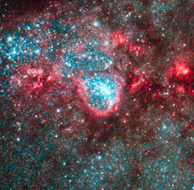Ever since the Hubble upgrade a few months ago I’ve been waiting to see the results of it getting back to routine science observations… especially for the new Wide Field Camera 3, which promised to return gorgeous imagery.
Well, the wait’s over. The first image is out, and it’s a nice one: star formation in the spiral arm nurseries of the nearby galaxy M83:
[You know the deal: click it to embiggen, or go here to grab a delicious 15 Mb 3900x3900 pixel version.]
M83 is about 15 million light years away, making it practically a next door neighbor for the Milky Way, as well as a tempting target for telescopes. Proximity = clarity in most cases, and with M83 we have a great view of its lovely spiral arms. This new image from Hubble’s WFC3 shows unprecedented detail, too. There are star clusters everywhere, factories cranking out baby stars by the millions. There are also something like 60 supernova remnants, the expanding gaseous debris from exploded stars, five times the number previously seen in this galaxy.
The colors are interesting. This picture is not quite true color. Sure, blue is blue, green is green, and red is red, but they also added a second version of red coming from the light of warm hydrogen gas (called Hα in astronomical parlance) as well as a fifth color: cyan (turquoise) coming from the light of warm, tenuous oxygen. That light is typically emitted from gas clouds making stars as well as the gas emitted from stars when they die (in fact, my PhD thesis was based on observations of this oxygen-light glowing from a ring of gas around an exploded star). You can see that this teal-like glow pervades the entire image: oxygen is everywhere! But it’s so thin it’s more like a hard laboratory vacuum than anything you could breathe.
 Also, if you look closely at the pockets of red clumpy gas, you can some that are edge-brightened, like a soap bubble. These are where stars are being born in vast numbers. Their mighty winds expand outwards, carving huge cavities in the gas. My favorite is the one in the middle left of the image, zoomed in here for your viewing awesomeness. The stars are so closely packed they blur together, and each that you can see here would dwarf the Sun in mass, size, and brightness. You can also see that the rim of the bubble is more pronounced below the star cluster, which means that the surrounding gas in the environment of the cluster is thicker there, and has piled up more as the expanding winds have snowplowed it.
Also, if you look closely at the pockets of red clumpy gas, you can some that are edge-brightened, like a soap bubble. These are where stars are being born in vast numbers. Their mighty winds expand outwards, carving huge cavities in the gas. My favorite is the one in the middle left of the image, zoomed in here for your viewing awesomeness. The stars are so closely packed they blur together, and each that you can see here would dwarf the Sun in mass, size, and brightness. You can also see that the rim of the bubble is more pronounced below the star cluster, which means that the surrounding gas in the environment of the cluster is thicker there, and has piled up more as the expanding winds have snowplowed it.
And everywhere in this picture are the dark ribbons and filaments of dust, dust, dust. These are long molecules (usually with lots of carbon) which are created by new stars and dying stars. They litter galaxies like M83 as well as our own. And while they make life difficult for optical astronomers who struggle to penetrate the thick veil and see what lies beneath, the dust is interesting all by itself… and adds a certain depth and grace to images like this one.
And, on the right of the big image, is the white glow of the galaxy’s nucleus. You can see detail of the dust, stars, and gas all the way down to the very center. It’s an amazing image, and I’m sure will keep astronomers busy for a long, long time.
What a great start to the return of the Hubble! And, as always, I can’t wait to see what’s next.